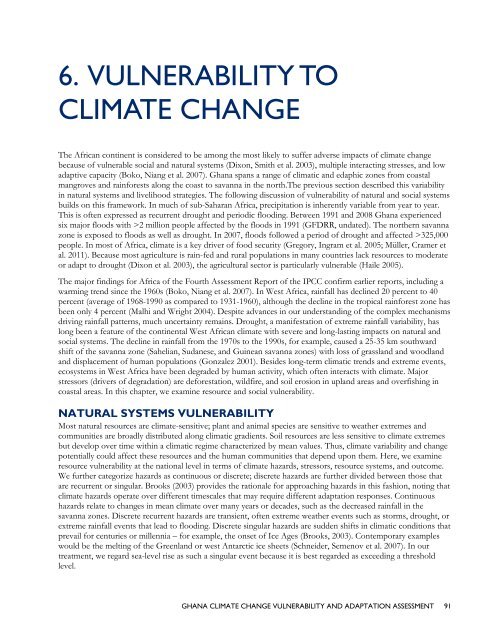ghana climate change vulnerability and adaptation assessment
ghana climate change vulnerability and adaptation assessment
ghana climate change vulnerability and adaptation assessment
- No tags were found...
Create successful ePaper yourself
Turn your PDF publications into a flip-book with our unique Google optimized e-Paper software.
6. VULNERABILITY TOCLIMATE CHANGEThe African continent is considered to be among the most likely to suffer adverse impacts of <strong>climate</strong> <strong>change</strong>because of vulnerable social <strong>and</strong> natural systems (Dixon, Smith et al. 2003), multiple interacting stresses, <strong>and</strong> lowadaptive capacity (Boko, Niang et al. 2007). Ghana spans a range of climatic <strong>and</strong> edaphic zones from coastalmangroves <strong>and</strong> rainforests along the coast to savanna in the north.The previous section described this variabilityin natural systems <strong>and</strong> livelihood strategies. The following discussion of <strong>vulnerability</strong> of natural <strong>and</strong> social systemsbuilds on this framework. In much of sub-Saharan Africa, precipitation is inherently variable from year to year.This is often expressed as recurrent drought <strong>and</strong> periodic flooding. Between 1991 <strong>and</strong> 2008 Ghana experiencedsix major floods with >2 million people affected by the floods in 1991 (GFDRR, undated). The northern savannazone is exposed to floods as well as drought. In 2007, floods followed a period of drought <strong>and</strong> affected >325,000people. In most of Africa, <strong>climate</strong> is a key driver of food security (Gregory, Ingram et al. 2005; Müller, Cramer etal. 2011). Because most agriculture is rain-fed <strong>and</strong> rural populations in many countries lack resources to moderateor adapt to drought (Dixon et al. 2003), the agricultural sector is particularly vulnerable (Haile 2005).The major findings for Africa of the Fourth Assessment Report of the IPCC confirm earlier reports, including awarming trend since the 1960s (Boko, Niang et al. 2007). In West Africa, rainfall has declined 20 percent to 40percent (average of 1968-1990 as compared to 1931-1960), although the decline in the tropical rainforest zone hasbeen only 4 percent (Malhi <strong>and</strong> Wright 2004). Despite advances in our underst<strong>and</strong>ing of the complex mechanismsdriving rainfall patterns, much uncertainty remains. Drought, a manifestation of extreme rainfall variability, haslong been a feature of the continental West African <strong>climate</strong> with severe <strong>and</strong> long-lasting impacts on natural <strong>and</strong>social systems. The decline in rainfall from the 1970s to the 1990s, for example, caused a 25-35 km southwardshift of the savanna zone (Sahelian, Sudanese, <strong>and</strong> Guinean savanna zones) with loss of grassl<strong>and</strong> <strong>and</strong> woodl<strong>and</strong><strong>and</strong> displacement of human populations (Gonzalez 2001). Besides long-term climatic trends <strong>and</strong> extreme events,ecosystems in West Africa have been degraded by human activity, which often interacts with <strong>climate</strong>. Majorstressors (drivers of degradation) are deforestation, wildfire, <strong>and</strong> soil erosion in upl<strong>and</strong> areas <strong>and</strong> overfishing incoastal areas. In this chapter, we examine resource <strong>and</strong> social <strong>vulnerability</strong>.NATURAL SYSTEMS VULNERABILITYMost natural resources are <strong>climate</strong>-sensitive; plant <strong>and</strong> animal species are sensitive to weather extremes <strong>and</strong>communities are broadly distributed along climatic gradients. Soil resources are less sensitive to <strong>climate</strong> extremesbut develop over time within a climatic regime characterized by mean values. Thus, <strong>climate</strong> variability <strong>and</strong> <strong>change</strong>potentially could affect these resources <strong>and</strong> the human communities that depend upon them. Here, we examineresource <strong>vulnerability</strong> at the national level in terms of <strong>climate</strong> hazards, stressors, resource systems, <strong>and</strong> outcome.We further categorize hazards as continuous or discrete; discrete hazards are further divided between those thatare recurrent or singular. Brooks (2003) provides the rationale for approaching hazards in this fashion, noting that<strong>climate</strong> hazards operate over different timescales that may require different <strong>adaptation</strong> responses. Continuoushazards relate to <strong>change</strong>s in mean <strong>climate</strong> over many years or decades, such as the decreased rainfall in thesavanna zones. Discrete recurrent hazards are transient, often extreme weather events such as storms, drought, orextreme rainfall events that lead to flooding. Discrete singular hazards are sudden shifts in climatic conditions thatprevail for centuries or millennia – for example, the onset of Ice Ages (Brooks, 2003). Contemporary exampleswould be the melting of the Greenl<strong>and</strong> or west Antarctic ice sheets (Schneider, Semenov et al. 2007). In ourtreatment, we regard sea-level rise as such a singular event because it is best regarded as exceeding a thresholdlevel.GHANA CLIMATE CHANGE VULNERABILITY AND ADAPTATION ASSESSMENT 91
















